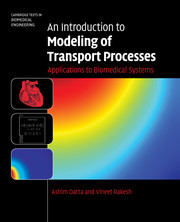Introduction and overview
Published online by Cambridge University Press: 05 June 2012
Summary
What does modeling involve? Why should we care about modeling? Do I have to be a math whiz to succeed? How can this book help me to get started in modeling (in case I do care)? These are some of the questions we try to answer in this introductory chapter. This chapter is critical and should not be skipped.
What is modeling?
By modeling, we mean developing a replica on a computer of a physical process that interests us so that we can manipulate the process on the computer. In contrast with a computer-aided design (CAD) model which deals mostly with geometric or solid modeling, shading, etc., we must include the detailed physics of the system in order to evaluate its performance. In short, such a model involves simplifying the geometry and physics of a real situation and solving the simplified equations that describe the physics, using a software that is primarily an equation solver.
You have modeled before. As a child, you learned that the area of a trapezoid is the height multiplied by the average of the two bases. If we program this on a calculator, so that we only have to input the height and the two bases and the calculator spits out the area, we have a model for area calculation.
- Type
- Chapter
- Information
- An Introduction to Modeling of Transport ProcessesApplications to Biomedical Systems, pp. xix - xxivPublisher: Cambridge University PressPrint publication year: 2009

